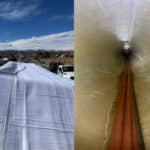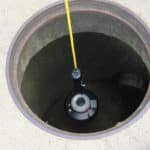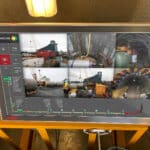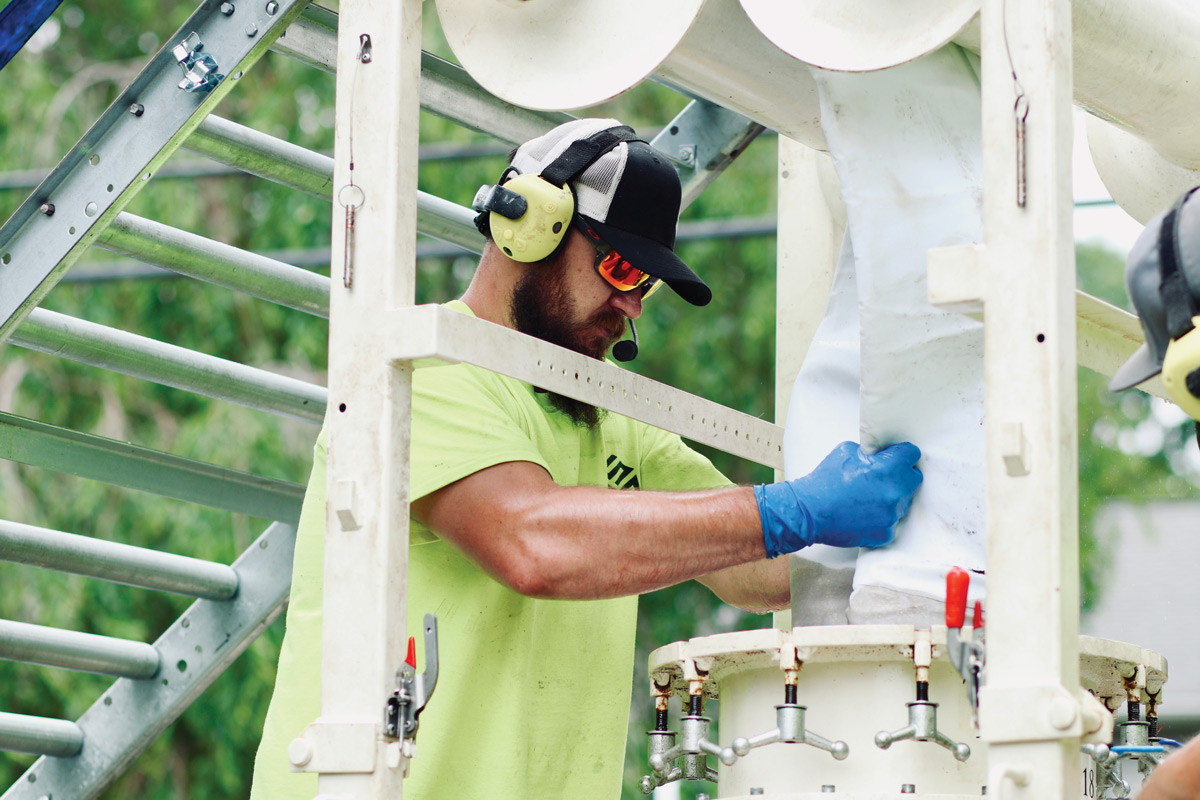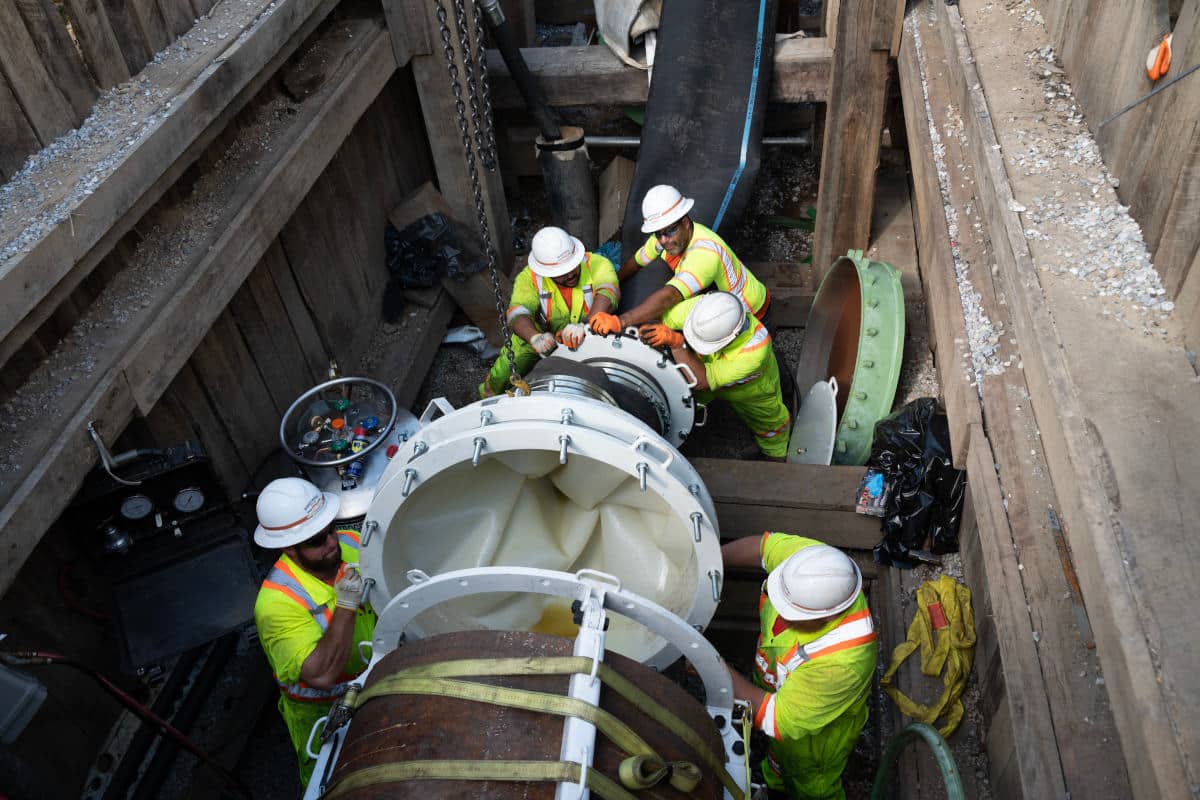
2025 Trenchless Technology Rehabilitation Project of the Year Honorable Mention
BGE 42-in. Herkimer Cast Iron Main
A 42-in cast iron Baltimore Gas and Electric (BGE) main in Baltimore was rehabilitated in three weeks using cured-in-place pipe (CIPP). The main, which runs under businesses, residences, a school and a railroad bridge, had been repaired 75 times with internal clamps and mechanical seals.
Trench-and-replace would have required extensive excavation over 75 joints, road closures, pits every 12 ft, costly steel pipe, and complex permitting. Two CIPL inversions were completed using three excavation pits and specialized equipment.
Project Details
Segment one was 208 ft and included four 90-degree bends and two 45-degree bends. At a 42-in drip pot 18.5 ft, a custom stainless steel bridge was built to support inversion and protect against over-pressurization within the annular space of the drip pot.
Segment two was 532 ft and included three 45-degree bends and a 16-in service tee being abandoned. A high-strength carbon fiber Structural Reinforcement Patch installed in the pipe covered over the void at the tee. CCTV crawlers and multi-camera models navigated multiple pipe offsets during inspections. Internal pipe surfaces were cleaned and prepared using grit and a spin blaster. Two high-CFM dust collecting vacuum units, creating over 50-mph airflow, reclaimed grit.
Installation involved loading the large diameter material into a steerable pressure drum. The liner was pneumatically inverted and maneuvered through the pipe while maintaining 8-psi during the ambient temperature curing. A Bluetooth/cellular remote pressure device provided real-time pressure readings of curing. An innovative anchoring device enabled work-flow efficiency; while segment one cured, the crew cleaned and lined segment two. Cleaning, inspection, lining and curing took three days.
The liner was depressurized and ends cut out. Post-lining CCTV inspection confirmed full adhesion of the liner to the host pipe. A 25-lb, 24-hr pressure test was done before restoring the main. A major challenge was the confined space of the pit. The 15 ft /25 ft pit was bordered by a wall and a loading dock, extremely tight for heavy vehicles and crews.
Excavations were below Baltimore’s water table, and a culvert was a contamination risk. An environmental subcontractor ran pumps 24/7 to prevent flooding. Lining was completed ahead of schedule; traffic flowed without interruption. CIPL was cost-effective, fast and a much less disruptive solution.
Why Project Is Outstanding
The 42-in. main was rehabilitated ahead of schedule, despite extreme conditions. Lining was the only viable solution to repair the 42-in. cast iron gas main. PPM invented an anchoring device that accelerated productivity and preserved workspace.
The newly designed ‘pancake’ anchored the liner in segment one after inverting so the crew could move to segment two. Without this, the first section had to finish curing before shifting to the next. Innovations that improved efficiencies included a tool called a spin blaster that cleaned and prepared the internal pipe surface, and a /cellular remote pressure device that enabled real-time pressure readings of internal curing.
Complex pipeline anomalies demanded adaptive strategies. The main, buried 10 ft, had 75 internal clamps and mechanical seals inside that had to be removed before lining. At a 90-degree bend and 42-in. drip pot 18 ½ ft deep, a bridge of stainless steel was built and installed to support the path of inversion and protect against future unintended over-pressurization within the annular space of the drip pot fitting. A drip pot at a 16-in service tee was being abandoned, leaving a void. A high-strength carbon fiber Structural Reinforcement Patch was installed inside the pipe to cover over the void at the tee.
Constrained spacing in the lining pit presented severe limitations. In a narrow alley bordered by a wall and a loading dock, the 15 ft deep/25 ft long pit was too tight for heavy vehicles and crews for cleaning and lining. BGE brought in a crane to lift the equipment in and out.
With pit excavations below the water table, there was high risk of flooding and contamination from the river and culvert. BGE employed an environmental subcontractor to run pump systems 24/7.
Project Details
Project Owner: BGE Gas Program Management
Engineer: Russell Bowie
Contractor: Progressive Pipeline Management
Value of Trenchless Project (US$): $7 million
Latest Posts
- 92-in. Stormwater Pipeline CIPP Rehab in Englewood, Colorado
- The Human Edge in an AI World: Why Skilled HDD Crews Still Reign Supreme
- Geotechnical Considerations for HDD to Mitigate Risk
- Understanding Manhole Inspections and Their Role in Infrastructure Management
- Product Showcase – VMT Launches TunnelHub
Next Up
HDD Academy | February 19-20, 2026 | Scottsdale, Arizona | Learn more

